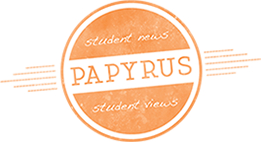Written by Kathleen Malone. Media by Kelsey Middleton.
Cursive writing. Whenever we hear those two words, it almost feels like something which has gone far away from us, something that has died with the rise of the age of computers. However, that doesn’t seem to be the case. Many studies show that cursive writing is actually a good thing and it’s making a comeback. Personally, I felt that cursive wasn’t around as much as it should have been and that it was something that was either dying or dead. Therefore, cursive wasn’t a topic that I was interested in until I started to read the articles about it.

Many of the articles about cursive handwriting discussed the positive reasons why cursive should still be taught and learned. The main arguments are we learn better when we write things down, there’s a need to be able to read cursive, it helps develop motor skills, and it allows people to be creative and make beautiful things. All of those are very interesting, and in today’s world maybe we should take another look at them.
In The Washington Post’s article “Once all but left for dead, is cursive handwriting making a comeback?“, Joe Heim shows that there are schools that still want their students to learn cursive handwriting, as it is required for standard learning. The article also mentions that when children learn to write in cursive, it helps them cognitively so they process words faster. He also states that children’s memories were much better if they wrote things down rather than typing them on a keyboard.
Continuing with “A Case For Cursive“, author Cindy Long has very similar points to the previous article. Long discusses improved writing speed and creativity, how the students seemed to be learning better when they wrote things down, and indicated that students’ memories were improved, as they were able to recall things that they had written down for classes.

“Why Cursive?“, presented by Cursive Logic, gives arguments as to why cursive is better than typing by bringing in evidence from other sources to help showcase their opinion. This shines a more positive light on the subject. The Federalist and Concordia University both have articles listing reasons why cursive should be brought back, seeming to only reinforce the statement that cursive should be reintroduced to school curricula.
Reading articles about cursive writing definitely changed my view on the topic. Instead of viewing it negatively, the research has been overwhelmingly positive, so I believe that cursive should be brought back and taught. Though there may be some people out there that disagree, I feel that cursive writing is a positive thing.
Cursive continues to make a strong case to stick around. Proponents fight the claim that it is dead due to increased use of computers and technology or the belief we won’t need something like that again. There are many positives to cursive writing, compared to a scarce search result of negatives. Cursive writing seems to be making a comeback in a big way, and there are many studies that show that cursive is improving the way children learn. Even though we’re in the computer age, handwriting still matters. Cursive isn’t going to be dying anytime soon.





























Handwriting matters — does cursive? Research shows that legible cursive writing averages no faster than printed handwriting of equal or greater legibility. (Sources for all research are available on request.) Further research shows that the fastest, clearest handwriters avoid cursive. They join only the most easily joined letter-combinations, leaving others unjoined, using print-like shapes for letters whose printed and cursive shapes disagree. (Many people who think that they “print” actually write in this practical way without realizing that they do so. The handwriting of many teachers comes close: even though, often, those teachers have never noticed that they are not at all writing in the same 100% print or 100% cursive that they demand that their students should write.) Teaching material for such practical handwriting abounds — especially in much of the UK and Europe, where such practical handwriting is taught at least as often as the accident-prone cursive that too many North American educators venerate. (Again, sources are available on request.) For what it’s worth, there are some parts of various countries (parts of the UK, for instance, despite their mostly sensible handwriting ) where governmental mandates for 100% joined cursive handwriting have been increasingly enforced, without regard for handwriting practicality and handwriting research, In those parts of the world, there are rapidly growing concerns on the increasingly observed harmful educational/literacy effects (including bad effects on handwriting quality) seen when 100% joined cursive requirements are complied with: http://morrellshandwriting.co.uk/blog/
Reading cursive, of course, remains important —and this is much easier and quicker to master than writing cursive. Reading cursive can be mastered in just 30 to 60 minutes, even by kids who print. Given the importance of reading cursive, why not teach it explicitly and quickly, once children can read print, instead of leaving this vital skill to depend upon learning to write in cursive? Educated adults increasingly quit cursive. In 2012, handwriting teachers were surveyed at a conference hosted by cursive textbook publisher Zaner-Bloser.. Only 37% wrote in cursive; another 8% printed. Most — 55% — wrote with some elements resembling print-writing, others resembling cursive. When even most handwriting teachers do not follow cursive, why glorify it? Cursive’s cheerleaders allege that cursive has benefits justifying absolutely anything said or done to promote it. Cheerleaders for cursive repeatedly allege research support — repeatedly citing studies that were misquoted or otherwise misrepresented by the claimant or by some other, earlier misrepresenter whom the claimant innocently trusts. What about cursive and signatures? Brace yourself: in state and federal law, cursive signatures have no special legal validity over any other kind. (Hard to believe? Ask any attorney!)
Questioned document examiners (specialists in the identification of signatures, verification of documents, etc.) find that the least forgeable signatures are the plainest. Most cursive signatures are loose scrawls: the rest, if following cursive’s rules at all, are fairly complicated: easing forgery. All handwriting, not just cursive, is individual. That is how any first-grade teacher immediately discerns (from print-writing on unsigned work) which child produced it. Mandating cursive to save handwriting resembles mandating stovepipe hats and crinolines to save clothing.
Kate Gladstone
DIRECTOR, the World Handwriting Contest
CEO, Handwriting Repair/Handwriting That Works
http://www.HandwritingThatWorks.com
handwritingrepair+media@gmail.com